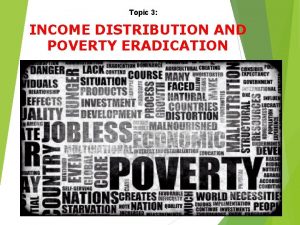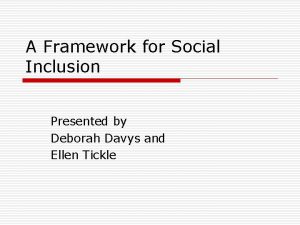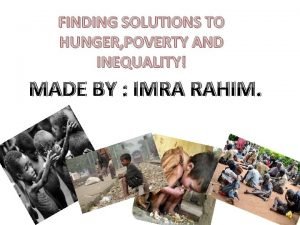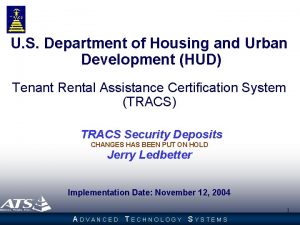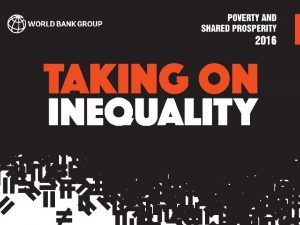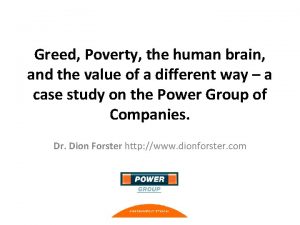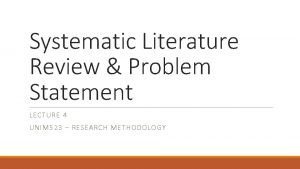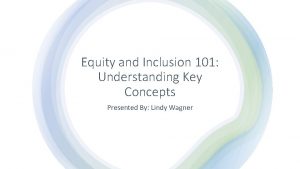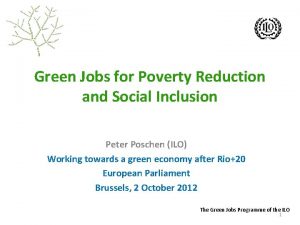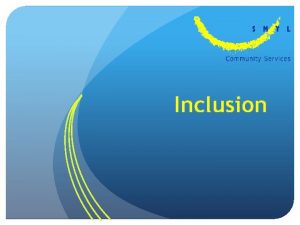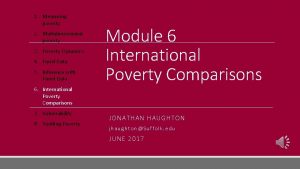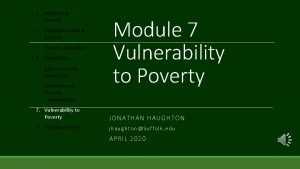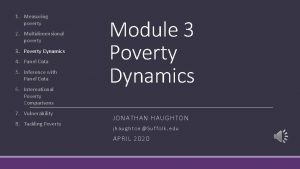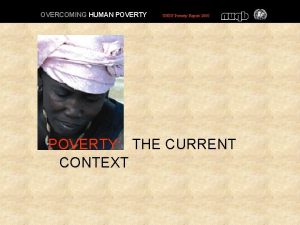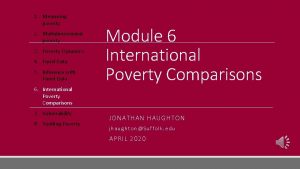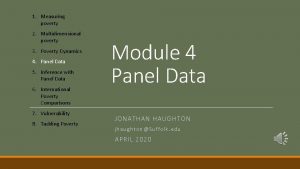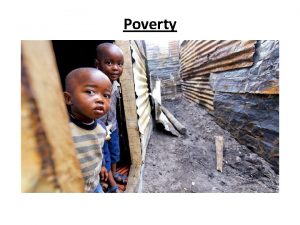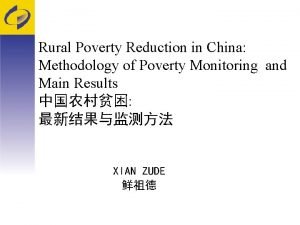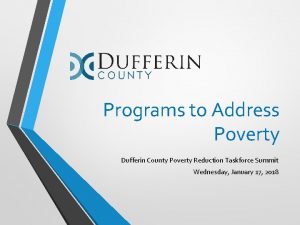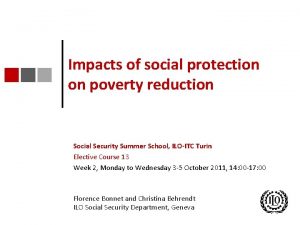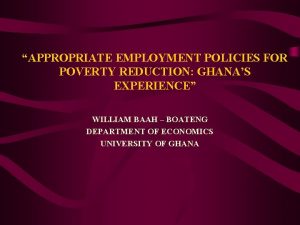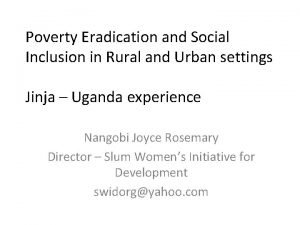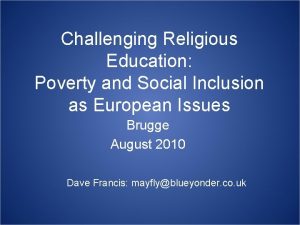Overview of Poverty Reduction and Social Inclusion Policies


























- Slides: 26

Overview of Poverty Reduction and Social Inclusion Policies in the Western Balkans Will Bartlett European Institute – LSEE London School of Economics 1

Outline • Pre-crisis growth and poverty reduction • Impact of economic crisis on poverty and social exclusion • Poverty reduction and social inclusion policies • Anti-crisis measures • What should be done in context of EU accession and regional cooperation? 2

Absolute poverty headcount at $5 per day 2% Croatia Bosnia 8% Serbia 17% 37% Macedonia Montenegro 49% Albania 60% Kosovo 82% 0% 10% 20% 30% 40% 50% 60% 70% 80% 90% 3

4

25 Poverty head count at national poverty line (% population) (2004 -2008) 20 -7% 15 -21% Macedonia -33% Albania Bosnia 10 Serbia -27% 5 0 Montenegro -39% 2004 -2007 2006 -2008 5

Poverty profiles • Rural poverty higher than urban – Bosnia LSMS 2007 rural 18%; urban 8% – Regional dimension within countries • Education and poverty – In Bi. H without degree 21%; with degree 1. 1% • Employment does not protect against poverty – In Albania >50% of poor are employed in low skilled jobs 6

Economic crisis • Global economic crisis struck in late 2008 as external drivers of growth collapsed – – Exports FDI Remittances Credit growth • Variable impact in 2009, – IMF support for Bosnia and Serbia, – Continued growth in Albania and Kosovo • Slow recovery in 2010, except for Croatia 7

10 Real GDP Growth 2008 -2010 (%) 8 6 Croatia Montenegro Serbia Bosnia Macedonia Kosovo Albania 4 2 0 -2 -4 -6 -8 2009 2010 8

20% Remittance Flows (% GDP) 18% 16% 14% 12% +11. 0% -13. 9% -4. 9% 2007 10% 2008 2009 8% 6% 4% +7. 0% 2% 0% Albania Bosnia Macedonia Serbia 9

Poverty and inequality in crisis • Poverty increased as growth, main driver of poverty reduction, collapsed • Increase in poverty 2008 -9 was higher in Macedonia (8. 4%) than in Croatia (3. 4%) – Possibly indicating lesser effectiveness of social safety net in mitigating poverty in Macedonia • Inequality increased – suggesting ability of elites to protect against income effects of crisis 10

35 At risk of poverty rate (%) 31. 1 30 29. 4 28. 7 Croatia 25 Macedonia 20 15 17. 4 2007 2008 18. 0 2009 11

10 Absolute poverty head count Serbia (%) 9. 2 9 8 7 6 5 6. 9 6. 1 2008 2009 2010 12

Macedonia: Urban equivalised income shares by quintile, 2008 -09 (%) 13

Social protection systems • Social insurance systems – Pensions (plus second private pillar in HR, MK, XK) – Health insurance (tax financed system in XK) – Unemployment benefits (limited coverage) • Social assistance programmes – Means tested social assistance (weak targeting) – Rights based social transfers (veterans benefits) – Family and child benefits 14

Pension systems • Pensions have a significant impact in reducing poverty • State-managed PAYG systems (AL, BA, SR, ME) – State managed pension schemes challenged by aging populations • Three pillar pension systems (HR, MK, XK) • Crisis impact on pension fund unit values – Despite vulnerability, three pillar reforms are proposed in BA, SR) 15

Population by age group (%) Kosovo Albania Macedonia Montenegro 65 + Under 15 Bosnia EU-27 Serbia Croatia 0 5 10 15 20 25 30 35 16

17

Health insurance • Health system is based on social insurance principles – Kosovo is an exception – tax financed system – State system covers minimum health needs • Large gaps in coverage due to non-payment of contributions • Private sector fills gaps in provision ( in Albania and Kosovo especially) 18

70% Proportion of respondents who consider general conditions in hospitals to be good or poor 58% 60% 50% 45% 40% Good 30% Poor 26% 20% 15% 10% 0% State hospitals Private hositals 19

Social assistance programmes • Means tested social assistance – Subjective assessments by social workers – In Albania, Ndhime Ekonomike, approved by local councils • Poor targeting and low coverage limits their effectiveness in reducing poverty – In Bi. H only 30% of assistance expenditure reaches poorest quintile – Roma and IDPs fall through the net – Kosovo, better targeting but low coverage reduces effectiveness 20

Categorical benefits • Rights based social assistance – Veterans’ benefits – In FBi. H, the government extended the rights of war veterans in 2008 and cash transfer expenditure increased sharply, up to 4% of GDP – Benefits to veterans are highly regressive, covering a larger proportion of the upper quintile of households than the poorest quintile in FBi. H. • Family benefits including child allowance 21

Policy measures responding to crisis • Public expenditure restraint – – IMF SBAs in Bosnia, Serbia, Kosovo and PCL in Macedonia (under negotiation Serbia) • Anti-crisis programmes – Reform / cut social assistance (BA, SR, HR, MK) – Reduced wages in public sector (BA, SR, HR, ME) – Public sector hiring restricted (BA, SR) – Public sector employment cut (SR) – Pension freeze (SR, HR) – Three pillar pension reform announced (BA, SR) 22

23

What should be done? • Modernisation of public sector to increase effectiveness – Social enterprises? Diverse providers? – Bring elites back as consumers of public services • Regularise informal sector to raise tax revenues – Also to close gaps in eligibility • Active inclusion involving targeted actions for deprived and vulnerable groups – Especially in line with EU Roma Strategy (2011) • Scope for regional cooperation – Learning from best practice – Use of IPA under Lisbon Treaty ‘horizontal’ social clause 24

Research at LSEE • Work on various aspects of social inclusion – Social impact of crisis – Health system reforms – Decentralisation and regional policy – Roma inclusion – Skills gaps and vocational education • LSEE research network on social cohesion – collaboration with local researchers and policy makers 25

Thank you for your attention! comments welcome at: w. j. bartlett@lse. ac. uk 04/12/2020 Will Bartlett LSE 26
 Absolute poverty and relative poverty
Absolute poverty and relative poverty Poverty reduction workgroup
Poverty reduction workgroup Social inclusion framework
Social inclusion framework Fondo de inclusión social energético
Fondo de inclusión social energético Social inclusion framework
Social inclusion framework Social thinking adalah
Social thinking adalah Social thinking social influence social relations
Social thinking social influence social relations Sdlc principles and practices
Sdlc principles and practices Bsbhrm506
Bsbhrm506 Security program and policies principles and practices
Security program and policies principles and practices Security program and policies principles and practices
Security program and policies principles and practices Security program and policies principles and practices
Security program and policies principles and practices Security program and policies principles and practices
Security program and policies principles and practices Relative and absolute poverty
Relative and absolute poverty Poverty and delinquency
Poverty and delinquency Sandra cisneros bio
Sandra cisneros bio St john chrysostom on wealth and poverty pdf
St john chrysostom on wealth and poverty pdf Poverty and hunger solutions
Poverty and hunger solutions Symbolic interactionism and poverty
Symbolic interactionism and poverty Hudco full form
Hudco full form Inequality and poverty
Inequality and poverty Greed and poverty
Greed and poverty Statement of the problem sample
Statement of the problem sample Traditional and systematic review venn diagram
Traditional and systematic review venn diagram What is the inclusion and exclusion criteria in research
What is the inclusion and exclusion criteria in research California map to inclusion and belonging
California map to inclusion and belonging Diversity equity and inclusion 101
Diversity equity and inclusion 101
